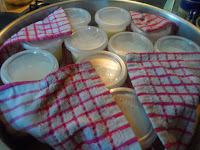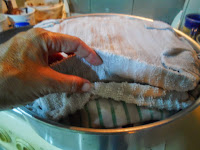
Una de las delicias más reconocidas de los andes venezolanos son sin duda los pastelitos, preparados con harina de trigo, estos crujientes y, maravillosamente rellenos y fritos acaparan la atención de cuanto viajero pasa por las zonas andinas, son perfectos para desayunar acompañados de chocolate caliente y espeso, divinos en una mañana fría, excelentes en una merienda acogedora, inigualable cuando sirve de pasapalo...Los pasteles andinos se rellenan con queso ahumado, con carne y arroz, con acelgas, ajoporro, champiñones o con trucha guisada, se cierran en forma redonda y se fríen hasta estar crujientes y dorados, su preparación merece atención y esmero para obtener un pastel para dioses. En esta ocasión vamos a enseñarles a prepararlos rellenos de carne molida con arroz.
One of the most renowned delights of the Venezuelan Andes are undoubtedly the cupcakes, prepared with wheat flour, these crisp and wonderfully filling and fried catch the attention of travelers who pass through the Andean zones, are perfect for breakfast accompanied by hot chocolate And thick, divine on a cold morning, excellent in a cozy snack, unparalleled when served as a snack ... Andean cakes are filled with smoked cheese, with meat and rice, with Swiss chard, garlic, mushrooms or stewed trout, close Round and fried to crisp and golden, their preparation deserves attention and dedication to obtain a cake for gods. On this occasion we will teach them to prepare them stuffed with ground beef with rice.
INGREDIENTES:
Para la masa:
1/2 K de harina de trigo todo uso1 tz de aceite vegetal1 1/2 tz de aguaSal
Para el relleno:
500 g. de carne molida3 Ajies dulces picados en brunoise1/2 Pimentón picados en brunoise1 rama sde Cebollin picados en brunoise3 dientes de Ajo picados en brunoise1 ramita de Cilantro picados en brunoise1 cdta de Comino en polvo1 tz de arroz blanco cocido2 Huevos salcochados picados en cuadritosAceite vegetal onotadoSal y pimienta
PREPARACIÓN:
Coloque la harina en un bol, haciéndole un hueco en el medio, agregue el aceite, el agua y la sal, mezcle bien hasta formar una masa elástica, amase suficientemente, no se desespere que ella poco a poco va agarrando consistencia y va a obtener una masa muy suave y que no se pegue a las manos. Deje reposar por 30 minutos.
En un caldero u olla grande, vamos a calentar a fuego medio un poco de aceite onotado y vamos a cocinar el sofrito de la carne, colocamos el ajo, el cebollin, los ajíes, el pimentón, y el cilantro, cocinamos unos minutos moviendo de vez en cuando sin dejar que se queme y luego añadimos las carne molida, el comino, sal y pimienta al gusto. Dejamos cocinar hasta que este en su punto. Debe quedar prácticamente sin nada de jugo para evitar que al freírlos estos salgan y salte el aceite y nos queme.
Una vez lista la carne, apagamos el fuego y vamos agregar la taza de arroz blanco cocido y los huevos picados previamente, mezclamos bien hasta integrar todos los ingredientes. Reservar.
Para empezar a preparar nuestros pastelitos andinos vamos a extender la mitad de la masa hasta que este muy fina, coloque pequeñas cantidades de relleno dejando 5 cm. aproximadamente entre uno y otro, hasta utilizar toda la extensión de la masa. Extienda la otra mitad de masa y cubra la primera con ésta, con un cortador redondo o un vaso de boca ancha, corte cada pastelito, apriete los bordes con los dedos o con la ayuda de las puntas de un tenedor y colóquelos en una bandeja enharinada. En un caldero u olla de boca grande vamos a calentar suficiente aceite vegetal y freímos los pasteles hasta dorar por ambos lados.

Otra opción de comerlos mas sanos es cocinándolos al horno, solo debe colocarlos sobre una bandeja plana, pintarlos con un poco de huevo y listo. Temperatura del horno 350º C. o hasta que los vea que se hayan dorado un poco, porque al horno no van a dorarse como cuando se hacen fritos.
Recipe:
INGREDIENTS
For the mass:
1/2 K all-purpose wheat flour1 tz of vegetable oil1 1/2 tz of waterSalt
For the filling:
500 g. Ground beef3 Sweet chopped chopped in brunoise1/2 Chopped paprika in brunoise1 branch of Cebollin chopped in brunoise3 garlic cloves chopped in brunoise1 sprig of cilantro chopped in brunoise1 tsp cumin powder1 tz of cooked white rice2 minced salted eggsOiled vegetable oilSalt and pepper
PREPARATION:
Place the flour in a bowl, making a hole in the middle, add the oil, water and salt, mix well to form an elastic mass, knead enough, do not despair that she is slowly picking up consistency and will get A very soft dough that does not stick to the hands. Let stand for 30 minutes.
In a cauldron or large pot, we will heat a little oil onotóado and we will cook the sofrito of the meat, we place the garlic, the cebollin, the peppers, the paprika, and the cilantro, we cook a few minutes moving of Occasionally without letting it burn and then add ground beef, cumin, salt and pepper to taste. We let it cook until it is ready. It should be practically without any juice to avoid that the fry them out and skip the oil and burn us.
Once the meat is ready, we put out the fire and we add the cup of cooked white rice and the eggs chopped previously, we mix well until integrating all the ingredients. Reserve.
To begin to prepare our Andean cakes we will extend half of the dough until it is very thin, place small amounts of filling leaving 5 cm. Approximately between one and another, until using the whole extension of the mass. Spread the other half of the dough and cover the first with a round cutter or a wide-brimmed glass, cut each cake, squeeze the edges with your fingers or using the tips of a fork and place in a floured tray . In a cauldron or pot of big mouth we will heat enough vegetable oil and fry the cakes until brown on both sides.
Another option to eat healthier is to bake them, just place them on a flat tray, paint them with a little egg and ready. Temperature of the oven 350º C. or until you see that they have browned a bit, because the oven will not brown as when they are fried.
Imagenes referenciales.






















